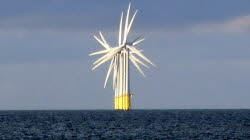By research scientists Ole Edvard Kongstein, Ole S. Kjos, Ana M. Martinez and Edel Sheridan, all of SINTEF Materials and Chemistry
Sunbeams and gusts of wind have one thing in common: they are unpredictable sources of energy that cannot be switched on and off according to our requirements.
If we do not need the power that solar cells give us when the sun is shining, or from wind-turbines when it is windy, the energy they produce must be stored if we are to be able to use it at all. At SINTEF, we have an idea for a battery that could be used for this purpose, and we have recently been given funds by the Research Council of Norway to realise our concept.
Our idea is based on creating giant batteries that would be located at certain sites in the electricity supply system. The batteries that we envisage would be able to absorb, and to release, a great deal of energy within a short time. In the event of a sudden power shortage in a renewables-based electricity system, such batteries would ensure that consumers always have a source of power available, whether the shortage lasts for days, or is over within a few seconds.

|
| Research scientists Ole Edvard Kongstein, Ole S. Kjos, Ana M. Martinez and Edel Sheridan, all of SINTEF Materials and Chemistry |
Increasing the value of renewables
If we manage this, we will drastically increase the value of solar and wind-power. We would also reduce the need for backup power generated from fossil resources.
Our battery would also reduce the need for expensive power transmission lines between regions. It could be charged with locally-generated electricity when this is cheap, for example at night, so that consumers could use it when they turn on their coffee-makers in the morning, or when they are cooking dinner.
Via their mobile telephones and electric cars, people in the industrialized part of the world have turned into users of the very latest development in the battery field; lithium-ion batteries, which can be charged both rapidly and often. These also give mobile telephones and electric vehicles the ability to do a great deal of work between charges. However, such batteries would be far too expensive to act as “buffering stores” in the grid.
Our solution is a battery that possesses many of the strengths of the Li-Ion battery. But it will be made of materials that are much cheaper, and more environmentally friendly. We believe that this can be done by combining our multidisciplinary expertise in batteries, electrochemistry, molten salts and materials.
Utilises gravity
Batteries transform chemical energy directly into electrical energy. They are built around two electrodes, which have traditionally been made of solid materials. In our battery, however, the electrodes consist of molten metal, and the electrolyte is a molten salt. One of the metals that we utilise is lighter than the other materials and therefore floats on top of them. This is one of the keys to our solution, because, thanks to the force of gravity, which is completely free, we can thus eliminate the expensive membrane that traditional batteries depend on to prevent short-circuits.
Batteries are charged and generate power by means of chemical reactions. These produce heat, and that is something that we will have to deal with in our battery. If its “insides” cool and solidify, the battery will not work. This makes size itself an important element of our design. The higher the volume relative to surface area, the easier it will be to keep the core of the battery hot. This is why we envisage making batteries that are as big as houses.
A liquid battery that is already on the world market is based on sodium and sulphur. But if we can make it, our battery will be both better and cheaper.
The least expensive way to store solar and wind energy is to convert large hydropower stations into pumped storage utilities. This involves installing turbines that alternate between acting as pumps and generating electricity. Taking this step would enable us to imagine a Norway that supplies Northern Europe with hydropower when the North Sea is calm, and then exploits cheap wind-power to pump water back into Norwegian reservoirs when it is blowing really hard over the Continent.
Less energy loss
However, this is only possible in countries with deep valleys and reservoirs up in the mountains; in other words, only in Norway and a few other countries. The rest of the world will have to depend on batteries if they are to make the most of the wind and the sun for stationary electricity generation. Furthermore, far less energy is lost in batteries than in pumped storage generating stations.
So it is all the more important for us that this project should succeed.
This article appeared in the Norwegian daily Dagens Næringsliv on Friday November 15, 2013.


